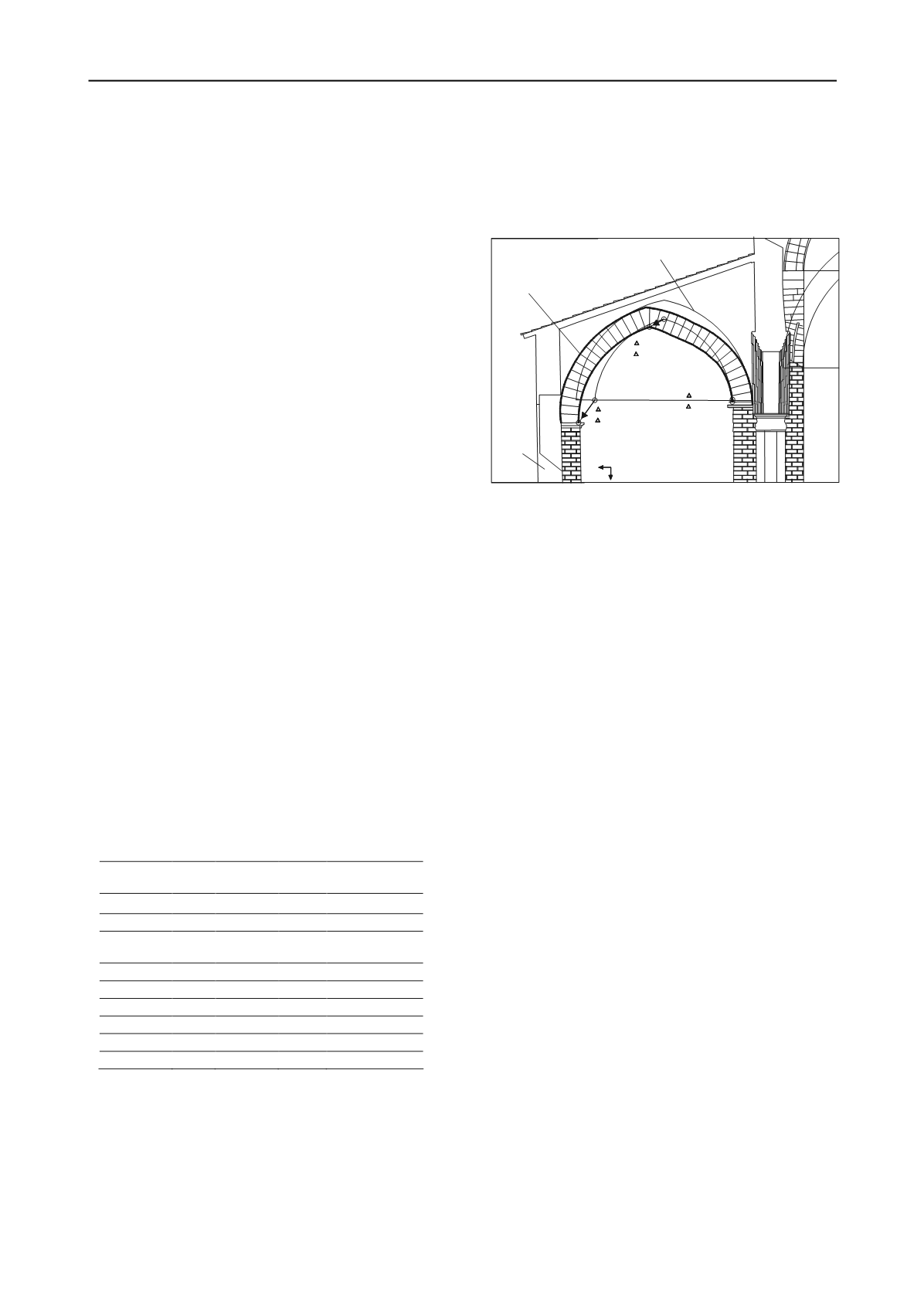
3144
Proceedings of the 18
th
International Conference on Soil Mechanics and Geotechnical Engineering, Paris 2013
Present shape
Likely original shape
Northern
wall
y
x
x=0.01m
y=0.09m
x=0.69m
y=0.93m
x=0.58m
y=0.30m
An idea of the cumulative differential settlements and
horizontal displacements towards the slope of the northern
wall can be drawn from the deformed shape of an arch
transversal to the axis of the northern aisle and adjacent to the
transept. According to a fairly credible reconstruction depicted
in Fig. 3, the northern springline of the arch might have
undergone an horizontal displacement so large as 69 cm and a
settlement of 93 cm relative to the other springline.
The pattern of the present-day fissuration and movements
remarkably resembles that observed recurrently since 1904 as
documented by photos and descriptions recorded in archival
sources (Di Fede, 2011).
The relevant inclinometer readings, begun on June 2011
and summarized in Tab. 3, show that the ground mass located
downhill of the longitudinal fracture undergoes significant
horizontal displacements and point out the existence of shear
surfaces at depths between 7 and 17m.
Based on these data and observations it is possible to
identify a slide mechanism shown in Fig. 2. Similar
mechanisms apply for the whole length of the Cathedral and
the parvis zone, the archiepiscopal palace and Ismani
hypogeum.
The above mechanism appear to be the main reason for the
anomalous behaviour of the ground-Cathedral system. It has
not been identified nor postulated up to now, and
consequently the attempts to stabilise the Cathedral were
unfounded. The sliding mechanism passes along the
subvertical fracture and through silty sands SL and altered
clays AGG. A stability analysis of this sliding mechanism,
which involves the North aisle of the Cathedral, points out
that the use of peak or residual shear strength parameters of
soils SL and AGG is not warranted. In fact, if peak
parameters are considered values of the factor of safety FS
within the range 1.4-1.6 will be calculated, whether if residual
strength is considered a value of FS much smaller that 1 is
obtained: these values are inconsistent with the observed
behaviour of the ground-Cathedral system. It is likely that the
shear strength is gradually approaching the fully softened
value for which the value of FS is 1.05.
Table 3. Superficial (top) horizontal displacement
h
, and depth
d
of
sliding surface indicated by inclinometric measurements from June
2011 to Dec. 2012. Location of inclinometer tubes relative to the
longitudinal fracture. U: uphill; D:downhill. N: north; NW: north-
west.
Inclinometer
tube
h
(mm) Direction
d
(m)
Location
S1*
2
/
/
U
S2*
12.8
NW 7
D
S3*
6
N 15;
22
D
S4*
4
/
/
U
S13
3.2
/
/
U
S16
8
NW 11;16
D
S20
8.3
N 17
D
S22
10
NW 6; 11
D
S26
2.3
/
/
U
8 CONCLUSIONS
The behaviour of Agrigento Cathedral has been
unsatisfactory since its construction in the XI century on the
crest of a very steep slope. Many attempts to stabilise the
ground-Cathedral system have failed because a sound
diagnosis of its problems has not been formulated.
Recent geotechnical investigations permitted to identify a
rather large sliding mechanism involving the North aisle of
the Cathedral as well as long adjacent stretches of the edge of
the slope. It is now evident that the preservation of the
Cathedral requires prioritarily the stabilisation of the slope.
Fig. 3. Distorted arch located at the eastern extremity of the North
aisle showing large differential movements between the springlines
cumulated probably during some centuries. (Reconstruction by Arch.
G. Renda).
9 REFERENCES
Commissione del Ministero dei Lavori Pubblici della Repubblica
Italiana, 1968.
Technical Report on the 1966 Agrigento
Landslide.
Città Spazio, N° 1-2. (In Italian).
Cotecchia V., Fiorillo F., Monterisi L., Pagliarulo R., 2005. Slope
instability in the Valley of Temples, Agrigento (Sicily).
Giornale di Geologia Applicata
, 91, 91-101.
Croce A., De Miro E., Fenelli G.B., Jappelli R., Liguori V., Morandi
R., Nocilla N., Pace E., Pellegrino A., Rossi Doria P., 1980.
Agrigento town and the Valley of Temples. Problems of
stability of the territory and of preservation of monuments.
Atti
del XIV Conv. Naz. di Geotecnica
, Florence, 1, 109-124. (In
Italian).
Di Fede M.S., 2010. L’ “invenzione”
della Cattedrale interventi di
restauro nella prima metà del Novecento. In G. Ingaglio
(editor):
La Cattedrale di Agrigento tra storia, arte,
architettura
. Edizioni Caracol, Palermo, 167-186. (In Italian).
Lizzi F., 1993. ‘Pali radice’ structures.
In S. Thorburn and G.S.
Litteljohn (editors),
Underpinning and retention
. Blackie
Academic & Professional, London, 84-156.
SYMBOLS
c
p
peak cohesion intercept
E
Young modulus
E
ed
constrained modulus
CF
clay fraction
k
coefficient of permeability
n
porosity
S
saturation degree
w
l
liquid limit
w
p
plasticity limit
w
n
natural water content
p
peak angle of shear strength
r
angle of residual shear strength
s
specific weight
sat
saturated unit weight
f
uniaxial strength


